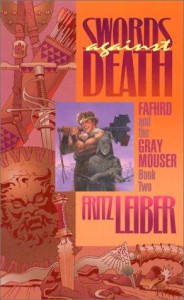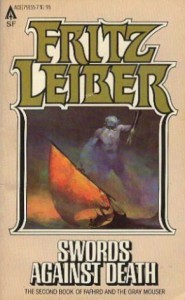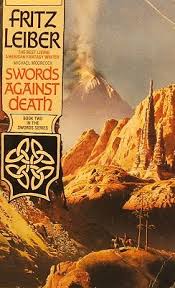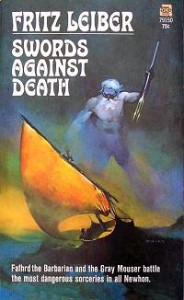Swords Against Death Re-Read: “Thieves’ House”
 Bill Ward and I are re-reading a book from Fritz Leiber’s famous Lankhmar series, Swords Against Death. We hope you’ll pick up a copy and join us. This week we tackled the third tale in the volume, “Thieves’ House.”
Bill Ward and I are re-reading a book from Fritz Leiber’s famous Lankhmar series, Swords Against Death. We hope you’ll pick up a copy and join us. This week we tackled the third tale in the volume, “Thieves’ House.”
Howard: I see now why I remembered this one so fondly. Consider the following ingredients: a twisting maze in a building so old that even its inhabitants don’t know all of its secrets: trap doors, secret passages, action, mayhem, a beautiful dancing girl, treasure, horror…
So far as I know, this is the first ever mention of a guild of thieves (remembering that the “earlier” story, “Ill Met in Lankhmar” was written decades after this one). A thief is referred to as being “a cutpurse of the first rank.” You combine that with the traps and treasure and the horrors and it’s pretty darned clear what a huge influence this story had to have had on original Dungeons & Dragons, not to mention all other fantasy games and all writers who grew up playing them.
 Bill: I noticed all that as well, and it had me wanting to roll to check for traps a few times.
Bill: I noticed all that as well, and it had me wanting to roll to check for traps a few times.
Howard: Hah! And how about the horror? Leiber hits it out of the park. In lesser hands we would just have seen some talking skeletons. Instead, we only ever glimpse them, or their actions. A character might brush against one, or hear the clack of them, or see a dead man’s neck with marks upon it that are strangely claw-like. Then there are the touches like the “old thieves” being able to see Fafhrd in pitch-black, or the flight of skeletal bats, or the jewel-like glimmer of eyes floating in the darkness… it’s just fabulous.
Bill: All that also struck me as particularly impressive. The scene where Fafhrd is being discussed by the ancient dead is especially creepy (as well as somewhat funny, a hard balance to strike), as is the teasing description of the emergence of the dead at the climactic part of the story. Not for nothing is Leiber also celebrated for his more horrific weird tales, such as “The Smoke Ghost,” and I was reminded again of his skill in this story.
Howard: Great point about the humor. Leiber manages to have a comforting thread of humor even as he’s chilling you with the supernatural.
 Another thing I loved is that all the principal characters are clever, and all of them have their own agendas. I love the Mouser’s last desperate plan to find the skull to save Fafrhd, dressed the while as an old woman. He’s so into the role he half believes it himself, because the Mouser is, like many actors, a little egocentric. I love how Fafhrd, truly in a desperate situation, plays upon the fears of his enemies and embellishes the tale of what happened to him to buy time. And then when the Mouser creeps in, he hears Fafhrd’s story — we can infer this through the Mouser’s actions — and performs that wonderful mummery with the floating skull and high disembodied voice that almost tricks the thieves.
Another thing I loved is that all the principal characters are clever, and all of them have their own agendas. I love the Mouser’s last desperate plan to find the skull to save Fafrhd, dressed the while as an old woman. He’s so into the role he half believes it himself, because the Mouser is, like many actors, a little egocentric. I love how Fafhrd, truly in a desperate situation, plays upon the fears of his enemies and embellishes the tale of what happened to him to buy time. And then when the Mouser creeps in, he hears Fafhrd’s story — we can infer this through the Mouser’s actions — and performs that wonderful mummery with the floating skull and high disembodied voice that almost tricks the thieves.
And how about Slevyas? What a clever and capable fellow. You can’t help but respect him. He’s much more agile than he looks and he’s an excellent commander. If he had simply been a little more open to the idea of the supernatural he might have survived.
Bill: And, in the case of F&GM, those are some great character moments as well. Fafhrd is a trained storyteller, and his barbarian poetic license really confuses some thieves that had never been on the receiving end of an epic before. And the Mouser in disguise is classic, a born actor whose most convincing flourish as a witch is producing a kitten from under his rags. These characters are fun, and you want to know even more about them every time Leiber gives us juicy bits like that.
 Howard: Absolutely. We get to know Ivlis only a little, but she has enough agency that she becomes more than a simple “prize to be won.” When she’s sitting at the table at the end with Fafrhd and the Mouser she has a voice of her own.
Howard: Absolutely. We get to know Ivlis only a little, but she has enough agency that she becomes more than a simple “prize to be won.” When she’s sitting at the table at the end with Fafrhd and the Mouser she has a voice of her own.
We could probably spend pages just going on about all the wonderful little touches like how Fafrhd gets lost, or how the Mouser kicks someone deserving while in disguise, or how its rumored the thieves have taken up worship of something in the cellars of Thieves’ House.
Honestly, I find it difficult to find much fault. The opening sequence might feel a little awkward because we don’t get any names and everyone has to be referred to by a string of descriptors (red-headed wench, fat thief, black-bearded thief). But as I went back again I saw Leiber was playing his game by certain rules. No one gets called by name in the prose until that name is used by a character in the text. Once they’re introduced by name, then we can get into their inner thoughts and the camera can close in on any one of them whenever Leiber wants and switch to their point of view. He’s so skilled at it that I may have to read it again just to watch for the switches.
Bill: I may read it again just to follow along with that technique. At some point I found I’d lost track of how the POVs were unfolding, and I just forgot about them and let myself get swept up in the action.
Howard: Right there with you. I’m looking forward to reading the next one, and I can just about guarantee I’ll revisit “Thieves’ House” again soon.
7 Comments